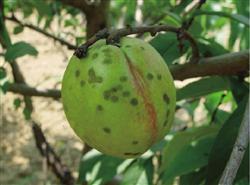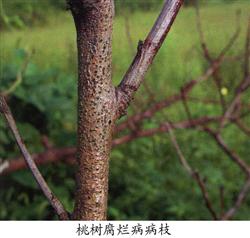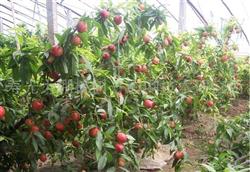Measures for auxiliary pollination of peach trees

Peach is a kind of tree with high self-flowering seed setting rate, but abnormal climate such as low temperature, overcast rain and frost will have adverse effects on fruit setting, and artificial pollination can effectively improve the fruit setting rate and promote the trend of fruit tidiness and enlargement. In the selection of pollination varieties, the varieties with large number of flowers and meeting at flowering stage are often selected, and multiple varieties are mixed or planted in the proportion of 1 ∶ 5 when the garden is established. Artificial pollination is generally carried out in the following ways: first, pollen collection of peach anthers adopts the following simple methods: the pollinated flowers collected are placed on a smooth paint table 1-2 days before the early flowering stage, and the flowers are gently rubbed with their hands, and then sifted to obtain anthers. Flowers can also be placed in an iron screen with an aperture of 0.25 cm, covered with smooth white paper under the screen, and then gently rub the flowers with your hands, and the anther falls on the white paper. Although there is some waste of anthers by using the above methods, the experiment shows that the anther loss rate is generally less than 20%, and the work efficiency is tens of times higher than that of taking anthers with tweezers. Second, the treatment methods of pollen are natural drying, hot Kang drying and electric lamp drying. The problems that should be paid attention to when drying the anther: ⑴ temperature: if the temperature is too high, the germination rate is low and the amount of powder is less; if it is too low, the drying time is long. The suitable drying temperature is 20-25 ℃, and the temperature is relatively stable. ⑵ time: at a temperature of 20-25 ℃, the drying time is generally about 36 hours. ⑶ must not expose pollen in the sun: the germination rate of sun-dried pollen is only 10-20%, while the germination rate of dried and dried pollen can reach more than 50%. Third, in addition to artificial pollination in the same year, the pollen obtained from the storage of pollen can be refrigerated for pollination of fruit trees in the greenhouse in winter or reused in the coming year. Generally, the pollen is sealed in a brown glass bottle; it can also be sealed in a plastic bag, wrapped in black paper, then packed in a plastic bag, and then stored in a refrigerator below zero. When in use, the germination test should be done. The viability of pollen stored by this method can generally reach more than 70% after 1 year. Fourth, during the full flowering period of artificial pollination, the collected pollen is made into saccharuria pollen liquid, which is sprayed with a sprayer. The formula of sugar and urine pollen liquid is 5 kg of water + 10 g of pollen + 10 g of urea + 5 g of borax + 100 g of sugar + a little adhesive. Or spraying 10-20 mg / kg of PCPA during flowering and 20 mg of tea acetic acid after anthesis can increase the fruit setting rate. The prepared pollen can also be mixed with talc or milk powder according to the proportion of 1 ∶ 5-10, dipped in the rubber head and lit with flowers, or put in a gauze bag, shake it on the tree, sprinkle pollen for pollination, and pollination time is carried out from the top of the crown to the inside of the crown. Repeated 3-4 times in the full flowering stage can significantly increase the fruit setting rate. Fifth, pollination by bees in orchards with more than 20% pollination and uniform configuration, releasing wall bees or bees at flowering stage can significantly increase the fruit setting rate. The pollination effect of wild bee fork wall wasp is better, and the fruit setting rate of peach orchard can be increased by 11%. The method is that 3-5 days before the peach tree blossoms, the bee cocoon is taken out from the 4-5 ℃ refrigerator or fruit bank and loaded into the honeycomb tube. Each honeycomb tube contains one bee cocoon, the head of the bee cocoon faces the tube mouth, and the tube mouth is sealed with thin toilet paper to facilitate the emergence of the bee out of the nest. Then hang the honeycomb tube (50 or 100 bundles) on the south wall of the orchard guard room near the recycling nest tube to facilitate recycling. 50-70 adult bees per mu.
- Prev

Efficient Management of Peach trees to promote High yield
Peach tree rot is also known as dry blight. After the peach tree is killed, the branches die and ulcer spots are formed in the big branches and trunks. If not treated in time, the whole plant will die soon. The main causes of the disease are: freezing injury and extensive management; improper fertilization and more autumn rain years, the dormancy of peach trees is delayed, which reduces the cold resistance of peach trees. With.
- Next

Control of Diseases and insect pests in Peach
1. Note that peach trees are chlorine-free crops. After application, it is easy to cause root rot, leaves withered and yellow, light trees weakening, and heavy ones leading to plant death. Therefore, do not use chlorine fertilizer. two。 Pay attention to watering during flowering. Watering at flowering stage can easily lead to the decrease of soil temperature and soil air content, affecting the growth and absorption of roots.
Related
- Moge, come on! The staff of the peasant association in the producing area of cantaloupe were frightened when the crowd gathered.
- Causes and Solutions of low Fruit setting rate of Apple
- Symptoms and control measures of passion fruit virus disease
- Fruit growing lesson: how do apple orchards keep high yields?
- Can you build orchards in the mountains? What are the pros and cons?
- How to manage the coloring period of Crisson grape?
- This paper introduces the processing technology of two kinds of fig products.
- How much is a month for retired teachers in rural areas by 2020?
- How can strawberry planting increase sugar content? We should pay attention to management in many aspects.
- What are the cultivation techniques on how to improve the yield of golden fruit?

